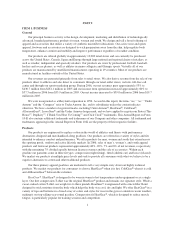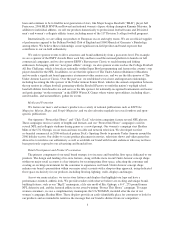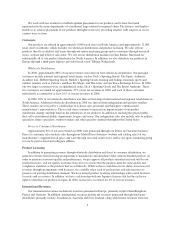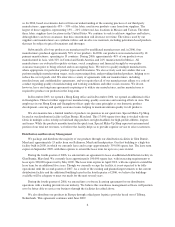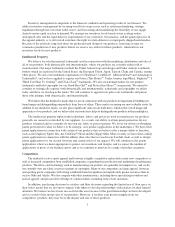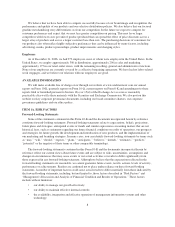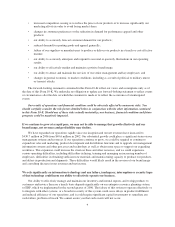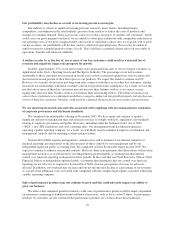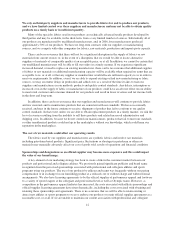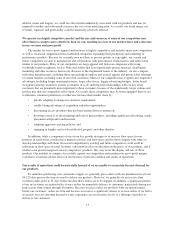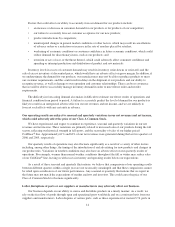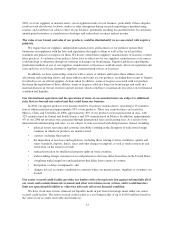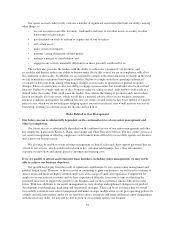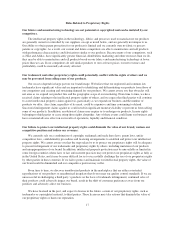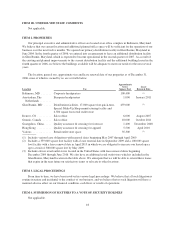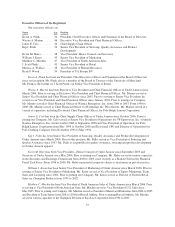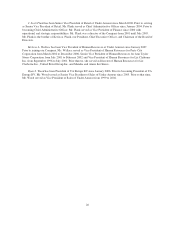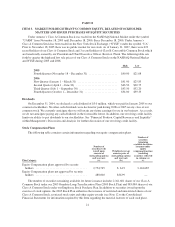Under Armour 2006 Annual Report Download - page 19
Download and view the complete annual report
Please find page 19 of the 2006 Under Armour annual report below. You can navigate through the pages in the report by either clicking on the pages listed below, or by using the keyword search tool below to find specific information within the annual report.alternatives, growth in the industry and our business could be adversely affected. In addition, because
performance products are often more expensive than traditional alternatives, consumers who are convinced that
performance products provide a better alternative may still not be convinced that they are worth the extra cost. If
industry-wide sales of performance products do not grow, our ability to continue to grow our business and our
financial condition and results of operations could be materially adversely impacted.
If we are unable to anticipate consumer preferences and successfully develop new products, we may not be
able to maintain or increase our net revenues and profitability.
Our success depends on our ability to identify, originate and define product trends as well as to anticipate,
gauge and react to changing consumer demands in a timely manner. All of our products are subject to changing
consumer preferences that cannot be predicted with certainty. Our new products may not receive consumer
acceptance as consumer preferences could shift rapidly to different types of performance or other sports apparel
or away from these types of products altogether, and our future success depends in part on our ability to
anticipate and respond to these changes. There can be no assurance that we will respond to changing preferences
in a timely manner. Failure to anticipate and respond to changing consumer preferences could lead to, among
other things, lower sales and excess inventory levels.
Even if we are successful in anticipating consumer preferences, our ability to adequately react to and
address those preferences will in part depend upon our continued ability to develop and introduce innovative,
high-quality products, and there can be no assurance of our ability to do so. In addition, there can be no assurance
that our strategy of continuing to expand the range of performance products that we offer into new product
categories will be well received by consumers or will not dilute our brand image and result in a shift of consumer
preferences away from our product lines. The failure to effectively introduce new products and enter into new
product categories that are accepted by consumers could result in a decrease in net revenues and excess inventory
levels, which could have a material adverse effect on our financial condition.
If the financial condition of our retail customers declines, our financial condition and results of operations
could be adversely impacted.
We extend credit to our customers based on an assessment of a customer’s financial condition, generally
without requiring collateral. We face increased risk of order reduction or cancellation when dealing with
financially ailing customers or customers struggling with economic uncertainty. A slowing economy in our key
markets or a continued decline in consumer purchases of sporting goods generally could have an adverse effect
on the financial health of our retail customers, which could in turn have an adverse effect on our sales, our ability
to collect on receivables, our ability to borrow under our revolving credit facility and our financial condition.
If we encounter problems with our distribution system, our ability to deliver our products to the market
would be adversely affected.
We rely on our distribution facility in Glen Burnie, Maryland for the majority of our product distribution,
and in the second quarter of 2007 we expect a second distribution facility, also in Glen Burnie, Maryland to be
operational. Our distribution facilities include computer controlled and automated equipment, which means the
operations are complicated and may be subject to a number of risks related to security or computer viruses, the
proper operation of software and hardware, electronic or power interruptions or other system failures. In addition,
because the majority of our products are distributed from two nearby locations, our operations could also be
interrupted by floods, fires or other natural disasters near our distribution facilities, as well as labor difficulties.
We maintain business interruption insurance, but it may not adequately protect us from the adverse effects that
could be caused by significant disruptions in our distribution facilities, such as the long-term loss of customers or
an erosion of our brand image. In addition, our distribution capacity is dependent on the timely performance of
services by third parties, including the shipping of product to and from our distribution facilities. If we encounter
problems with our distribution facilities, our ability to meet customer expectations, manage inventory, complete
sales and achieve objectives for operating efficiencies could be materially adversely affected.
11


